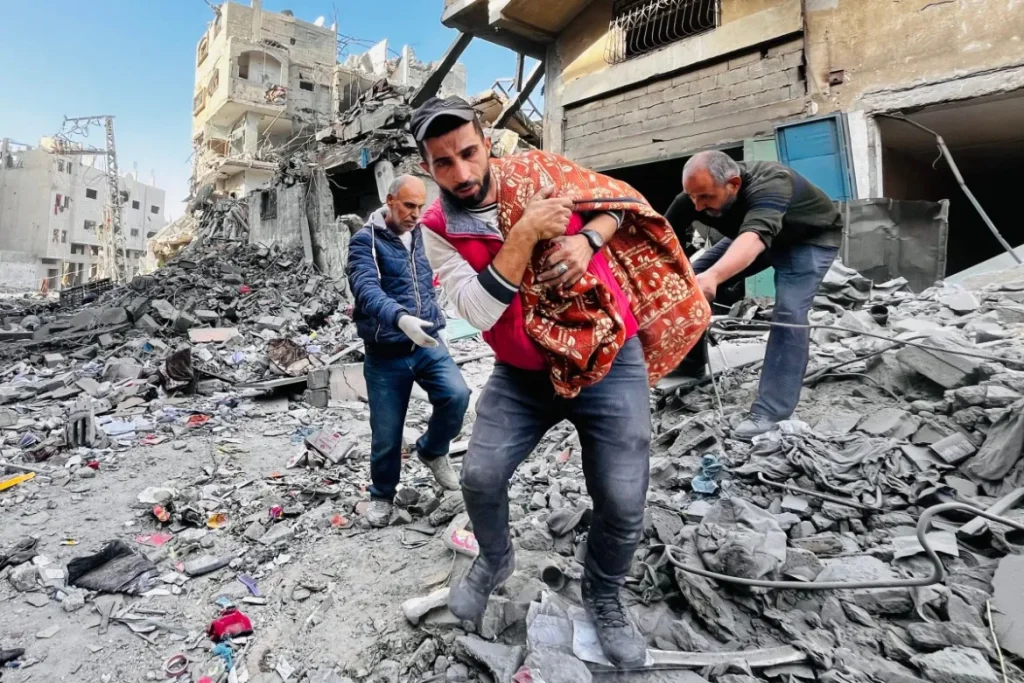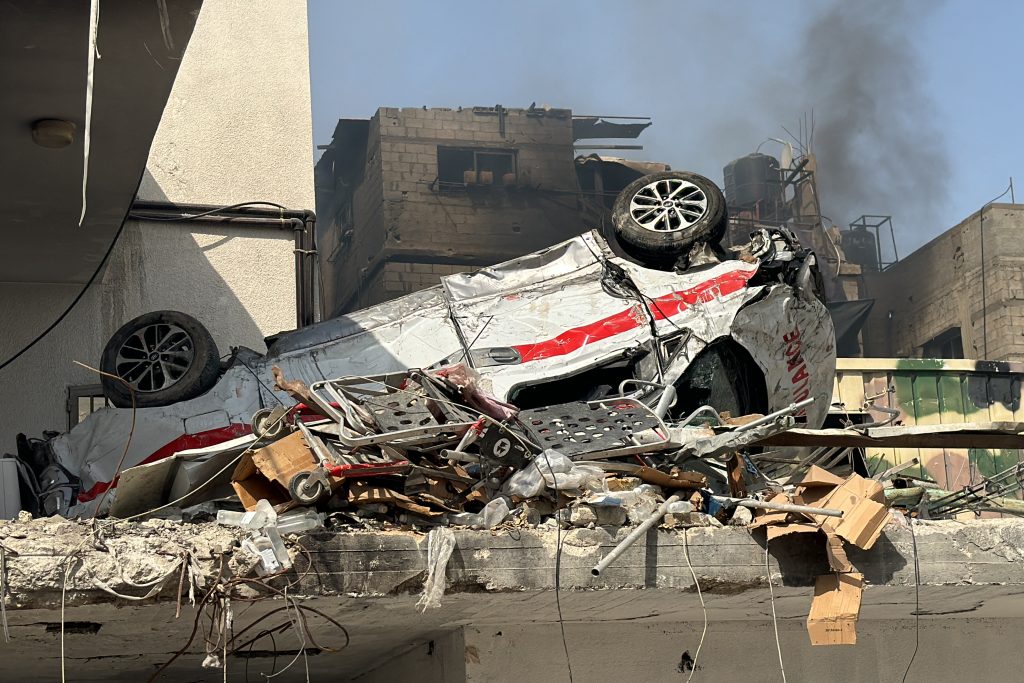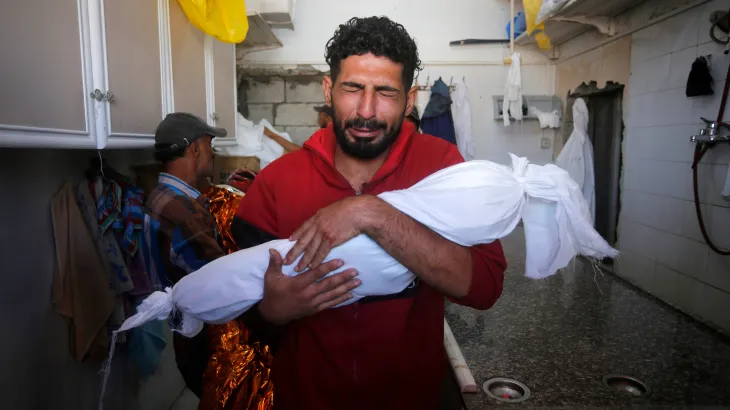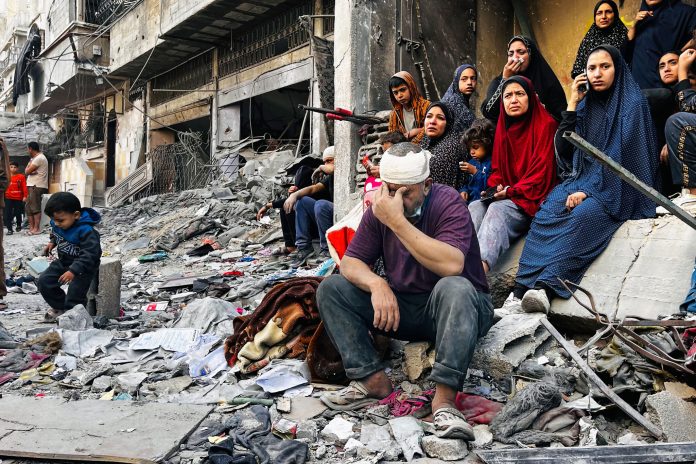On Tuesday, the northern Gaza town of Beit Lahiya experienced one of the deadliest airstrikes in recent months, with at least 93 Palestinians killed or missing and dozens more wounded, according to the Gaza Health Ministry. The airstrike targeted a residential building in Beit Lahiya, resulting in numerous civilian casualties, including at least 20 children, according to medical sources on the ground. Footage from the scene showed devastated families, rescue teams struggling amidst the rubble, and makeshift bodies wrapped in blankets outside the heavily damaged four-story building.
The attack has raised immediate international concerns. The United States, one of Israel’s key allies, quickly responded to the incident, calling it “horrifying.” Matthew Miller, a spokesperson for the U.S. State Department, expressed concerns about the high casualty count, adding that American officials have asked the Israeli government for an explanation. In a press statement, Miller acknowledged reports indicating that many of those killed in the airstrike were children and emphasized the need for a clear account of the circumstances surrounding the strike.
The United Nations Human Rights Office expressed dismay, labeling it “one of the deadliest single attacks in nearly three months,” and called for a “prompt, transparent investigation.” The scale of destruction and loss has led to heightened concerns from humanitarian organizations operating in the region, many of which are already overwhelmed by the crisis. Philippe Lazzarini, head of the United Nations Relief and Works Agency for Palestine Refugees (UNRWA), voiced alarm over escalating attacks on civilians, referring to the incident as a “collective punishment” that worsens an already dire humanitarian situation for Gaza’s civilians.

Eyewitnesses describe a night of chaos in Beit Lahiya. One resident, Ismail Ouaida, was present at the scene, attempting to aid in recovery efforts amidst the devastation. “There are tens of martyrs (dead) — tens of displaced people were living in this house. The house was bombed without prior warning,” Ouaida said in a video circulated by local media. “Martyrs are here and there, with body parts hanging on the walls,” he added, underscoring the scene’s graphic reality. Civil defense and ambulance teams have struggled to reach certain parts of the area, with rubble blocking access routes, further hampering rescue efforts.
Tuesday’s airstrike follows a grim pattern in northern Gaza, where intense Israeli strikes have continued for nearly three weeks. Gaza’s health ministry warned that emergency services were severely limited, with hospitals overwhelmed and some forced to evacuate, leaving critical patients unattended. Kamal Adwan Hospital, near Beit Lahiya, was evacuated, and without immediate medical care, “critical cases without intervention will succumb to their destiny and die,” the ministry reported.
The health infrastructure in Gaza has been crippled, with limited access to resources and continued civilian displacements exacerbating the crisis. According to the Palestinian Civil Emergency Service, an estimated 100,000 people are currently trapped in northern areas, including Jabalia, Beit Lahiya, and Beit Hanoun, without adequate food, medical supplies, or safe passage to other regions. Reuters has not independently verified the exact number of trapped civilians, but the statement aligns with reports from other humanitarian organizations in the region.

Northern Gaza’s civilian population has experienced severe displacements as Israeli forces press forward in their campaign to dismantle Hamas’s military operations, which Israel states are largely concentrated in the northern regions. The Israeli government has cited security concerns as justification for the intense air and ground operations aimed at Hamas, but the civilian toll has steadily escalated, with Gaza’s health ministry reporting more than 43,000 Palestinian deaths since the campaign began a year ago.
The strike in Beit Lahiya comes amid Israel’s intensified operations against Hamas, following a series of escalating hostilities that began over a year ago. The Israeli government has yet to release a statement directly addressing Tuesday’s incident, though military officials have previously disputed casualty figures reported by Gaza’s Hamas-run media office, claiming they are often exaggerated. However, civilian casualties have drawn increasing scrutiny from both allies and adversaries.
While the U.S. has largely supported Israel’s security efforts, Tuesday’s high casualty toll prompted sharp comments from American officials. The State Department reiterated concerns about the “horrifying” toll on civilians and urged Israel to adhere to international standards in its operations. The U.N. has similarly condemned the attack, adding pressure for an independent investigation to determine the facts and assess accountability.
Tuesday’s events coincide with a new Israeli legislative action barring the UNRWA from operating within the country, a move that could significantly impact humanitarian relief efforts in Gaza. Israel’s parliament passed the law on Monday, citing concerns that some UNRWA staff had direct ties to Hamas or were otherwise involved in the October 7, 2023, attacks on Israel, which claimed 1,200 lives and led to the capture of over 250 hostages. Israeli officials pointed to the involvement of a small group of UNRWA staff members affiliated with militant activities as grounds for the legislation.
UNRWA’s Lazzarini denounced the decision as “collective punishment” and emphasized the potential effects on vulnerable Palestinian communities, many of whom depend heavily on UNRWA for daily essentials, including food, healthcare, and shelter. With Gaza’s 2.3 million people largely dependent on international aid, the restrictions on UNRWA operations in the region threaten to further destabilize civilian life.
The ongoing conflict in Gaza has had reverberations throughout the Middle East. Israel’s bombardment of southern Lebanon and ground incursions against Hezbollah forces have contributed to a broader regional escalation. Hezbollah, an Iran-backed Lebanese group and ally of Hamas, has engaged in sporadic exchanges with Israeli forces near Lebanon’s southern border. Both Israel and Hezbollah have fortified positions along the contested border in response to each other’s movements.

The conflict has also drawn in Western nations, many of which have condemned the violence and underscored the need for a ceasefire. European leaders and humanitarian agencies have called for a halt to hostilities, stressing the need to protect civilians and ensure humanitarian aid can reach those most in need. As civilian casualties mount, diplomatic efforts have intensified, with several nations seeking to mediate a temporary ceasefire to allow relief efforts into Gaza.
International human rights organizations have condemned the high civilian toll in Gaza and urged world leaders to intervene. Amnesty International and Human Rights Watch both issued statements on Tuesday condemning the Beit Lahiya strike and calling for an investigation into potential violations of international humanitarian law. Human Rights Watch called on Israel to take “immediate steps to mitigate harm to civilians” and emphasized the responsibility of all parties in a conflict to ensure civilian protection.
The growing casualty list and displacement crisis in Gaza underscore the need for diplomatic intervention, yet, as it stands, few options have been effective. Mediated talks between Israel, Hamas, and regional stakeholders have so far failed to produce a sustainable peace framework. Analysts caution that without an immediate de-escalation, Gaza’s humanitarian crisis could deepen further, leading to even greater loss of life and regional instability.
As Gaza endures another night of conflict, the humanitarian cost weighs heavily on the international community. Tuesday’s events in Beit Lahiya are emblematic of the broader challenges in the conflict, with high civilian casualties, international condemnation, and escalating retaliatory strikes. While both Israel and Hamas remain entrenched in their positions, voices from across the globe continue to call for a path toward de-escalation, underscoring the urgent need for diplomacy and a recommitment to peace.
The U.S. and the U.N., along with other global entities, face pressure to take a more active role in negotiating a humanitarian ceasefire to prevent further tragedies like Beit Lahiya. For those in Gaza, however, Tuesday’s strike is a harsh reminder of the ongoing human cost of this protracted conflict.




